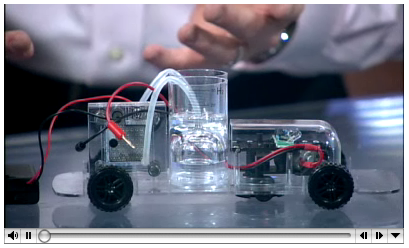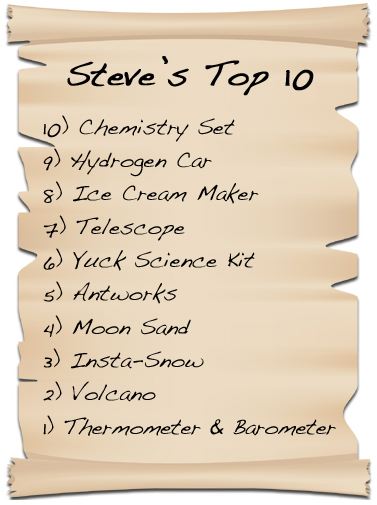Smart Toys for 2007

It seems that "Top 10 Lists" and Cyber Shopping go hand in hand… and my inbox is stuffed this morning with questions from people wanting to know about my top picks for toys. I’m flattered by the inquiries, but at the same time I had to stop and ask the question, “What’s my criteria for selecting the best toys for this holiday season?” I have to admit that being a teacher helps to shape my opinion, but I also know that just because a toy is deemed educational doesn’t mean that it’s fun. I’ve struggled with this idea as a toy designer myself, and I realize that it takes a certain skill to create a toy that combines a cool factor with just the perfect amount of learning. You know that a toy is a real winner when kids can hardly wait to show it to a friend. The category of science toys continues to grow and flourish because kids are naturally inquisitive and want to learn the “secret” behind the gee-whiz. That’s why it’s hard to beat a good chemistry set or any interactive toy that gives kids the opportunity to explore and learn… and have loads of fun at the same time.
Now that you know my criteria for selecting cool toys, here are a few of my choices the best smart toys for 2007.
 Chem 2000 Chemistry Set – Everything you want in a chemistry set. Great instructions, cool lab equipment and a sense of adventure.
Chem 2000 Chemistry Set – Everything you want in a chemistry set. Great instructions, cool lab equipment and a sense of adventure.
Fuel Cell Car – Imagine building a model car that runs on water! It only took a few minutes for my son to say, “This is going to be my science fair project.” And it took me two seconds to scream, “Yes!”
Ice Cream Maker Ball – It’s a really novel way to make ice cream. It makes my top list because of the way I’ve seen kids respond to the toy.
YUCK! – The name says it all. Uncover the secret formulas to make some really cool and gross concoctions.
AntWorks Ant Farm – When both kids and adults are fascinated by the same toy, you’ve got a winner… and you really get attached to those little ants!
Insta-Snow – Okay, I’m allowed to include one of my own products in the list. The facial reaction says it all when the powder literally erupts into fluffy snow.
Great Geysers – Mentos and soda, anyone? Explore the science behind the exploding geyser and learn how to turn this cool reaction into the perfect science project for school.
Moon Sand – You have to touch this stuff to believe it. Looks and feels like regular sand, but it can be molded into any shape. Warning… you can’t keep your hands out of the sand.
Snap Circuit – A great interactive toy that teaches the basics of electricity and circuits. Very cool projects with buzzers, lights, motors and switches.
Enviro Battery – Who needs a battery when you have a potato? Power a light and sound a buzzer using a battery made from zinc and copper an enviro battery.
Oh, there's yet another benefit to finding Smart Toys… getting to spend quality time with your kids as you both learn and explore. Hopefully your home is filled with the sounds of ooohs & ahhhs this holiday season (and remember that the Mentos Geyser is an outdoor activity… unless you're at a friend's home).




Thank you for the list of top 10 toys, but as an 8th grade Physical Science teacher, I try to stress with my students that we don’t use toys — we use Technical Objects for Young Scientists.
Could you recommend science kits for a 4 1/2 year old who is always doing experiments with anything he can get his hands on, i.e. flour, nuts, milk, pretzels, pebbles etc.
I am 75 years old, but am just as (or more) excited watching your segment than kids are. Can you tell me where I can purchase the fuel cell car and the moonsand? My grandson will be jumping up and down thrilled.
Steve Houdeshel — I like the TOYS thing… Technical Objects for Young Scientists! You are probably aware of the enormously popular program by Miami University called Terrific Opportunities for Young Scientists. Cool idea.
–Steve
Denise – Here are a few ideas for your young scientist…
Test Tube Adventures
Moon Sand Starter Kit
Shaker Slime Science Kit
Blizzard in a Bucket
Mad Scientist Laboratory – Very good!
Magna-Tiles
Color Mixing Pitcher
Find It Game – Kids love this one!
Insta-Worms – Make gooey polymer worms
Love your “toys”…….my students love them, too!
Your toys, ideas, and experiments help my students learn
and have fun doing it! They love Science. THANKS for your
creative way to help kids learn….keep ’em coming….
Side note to you: Do you need anyone to help you market
your products/do demonstrations, do workshops in Texas??
I’d love to be part of your team, if you are looking to
expand……I really believe in your ideas and products as
I’ve seen what reactions they produce in classrooms….email
back to me at my above address……thanks!
Mr. Spangler:
I really appreciate what you are doing with science education, but I think you send an incorrect message with your video on Hydrogen Oxygen video, calling it a renewable energy source. All of the hydrogen that you or anyone uses has to be produced and it costs more energy than we will ever get back. Your fuel cell car requires a battery to separate the hydrogen and oxygen. The battery is produced in a factory and it all costs.
From what I have read the fuel cell technology is not going to be very useful for a long time. This is probably one of the reasons that the oil companies are pushing it with the car companies, because if we pursue fuel cells we will be burning oil for a long time.
Hydrogen is one of the ways we can store energy and we can use solar or wind to generate the hydrogen. So hydrogen is a great storage technology for energy, but to call it a renewable energy source is quite misleading. The companies that are serious about using hydrogen energy are adding it to bio-fuels or just burning it directly, because fuel cells are not ready and probably won’t be for some time
We can also store energy as compressed air. Again it is not a source of energy, but it is a relatively safe storage technology, Unlike hydrogen that can be used with only a few modifications of our current engines, compressed air would require an entirely different engine and the air would not be burned, but it would provide the energy for locomotion.
Again I like and appreciate what you are doing, but I feel like those of us that teach science have an obligation to make the attempt to not send misleading messages.